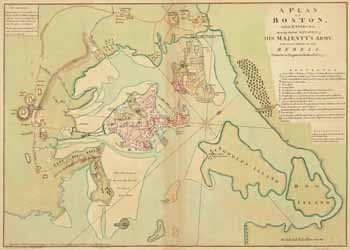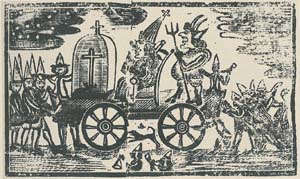 The 8 Sept 1845 Exeter News-Letter followed up the tale of James Cochran’s captivity and return with remarks about his son—though it got that man’s name wrong.
The 8 Sept 1845 Exeter News-Letter followed up the tale of James Cochran’s captivity and return with remarks about his son—though it got that man’s name wrong.
The 8 November Portsmouth Journal of Literature and Politics reprinted the first paragraph of that account, correctly naming the man as John Cochran:
He led a sea-faring life in his younger days, and sailed out of Portsmouth a number of years, as a ship-master, with brilliant success. A short period before the war of the Revolution broke out, he was appointed to the command of the fort in Portsmouth harbor. The day after the battle of Lexington, he and his family were made prisoners of war by a company of volunteers under the command of John Sullivan, afterwards the distinguished Major General Sullivan of the Revolution, President of New-Hampshire, &c. Captain Cochran and his family were generously liberated on parole of honor.
That paragraph, flattering to both Cochran and Sullivan, now came with the endorsement of one of John and
Sarah Cochran’s daughters, who had moved back to Portsmouth, New Hampshire.
It was, however, wrong. The move on Fort William and Mary led by John Sullivan (shown above) happened four months before the Battle of Lexington and
Concord, not the day after. And to read John Cochran’s own accounts from December 1774, it was much less friendly than this retelling describes.
The
Portsmouth Journal didn’t name the Cochran daughter or state her age, so we don’t know if she was old enough to recall these events herself or had heard about them from her parents and older siblings.
She provided some new anecdotes:
Not far from this time Gov. J[ohn]. Wentworth took refuge in the Fort, and Captain Cochran attended him to Boston. In his absence the only occupants of the fort were Mrs. Cochran, a man and a maid servants [sic], and four children.
At this time all vessels passing out of the harbor, had to show their pass at the Fort. An English man-of-war one day came down the river, bound out. Mrs. C. directed the man to hail the ship. No respect was paid to him. Mrs. C. then directed him to discharge one of the cannon. The terrified man said, “Ma’am I have but one eye, and can’t see the touch-hole.” Taking the match, the heroic lady applied it herself; the Frigate immediately hove too [sic], and showing that all was right, was permitted to proceed.
For this discharge of duty to his Majesty’s Government, she received a handsome reward.
Again, the timing of this event seems off. Sarah Cochran appears to have been on the family farm rather than at the fort when Gov. Wentworth departed in August 1775. The New Hampshire Patriots would hardly have let her take charge of the guns, and there was little
gunpowder left anyway. If something like this story happened, it was probably earlier, under royal rule.
The daughter’s account continued:
It was thought by some of the enemies of Gov. Wentworth that he was still secreted at the fort, after he had left for Boston. A party one day entered the house in the Fort, (the same house recently occupied by Capt. Dimmick), and asked permission of Mrs. Cochran to search the rooms for the Governor.
After looking up stairs in vain, they asked for a light to examine the cellar. “O yes,” said a little daughter of Mrs. C. “I will light you.” She held the candle until they were in a part of the cellar from which she well knew they could not retreat without striking their heads against low beams, when the roguish girl blew the light out.
As she anticipated, they began to bruise themselves, and they swore pretty roundly.—The miss from the stairs in an elevated tone cried out, “Have you got him?” This arch inquiry only served to divide their curses between the impediments to their progress and the “little Tory.”
Was this “little daughter” the same one telling the story or an older sister of the narrator? Was this an anecdote from the
militia raids on the fort in December 1774 or truly a search for the departed governor months later?
The
Portsmouth Journal then returned to the text from the
Exeter News-Letter, adding only one parenthetical correction:
Captain John Cochran, (who was a cousin, and not the father, as has been stated, of Lord Admiral Cochran) immediately joined the British in Boston; and, as it was believed, being influenced by the double motive of gratitude towards a government that had generously noticed and promoted him to offices of honor, trust, and emolument, and for the sake of retaining a valuable stipend from the Crown, remained with the British army during the war. It is due to his honor to state, however, that he was never known to take an active part in the conflict.
At the close of the war, he returned to St. Johns’, New-Brunswick, lived in the style of a gentleman the remainder of his days, and died at the age of 55.
John Cochran’s sister and then his daughter, both living in America, apparently didn’t want people to think he was too fervent in his loyalty to the Crown. Therefore, they insisted he was “never known to have taken an active part in the conflict.”
That’s a direct contradiction to what Sarah Cochran told the
Loyalists Commission back in 1787. She described her husband as working for both the British army and the Royal Navy, including in the invasion of
Rhode Island, and
Abijah Willard backed her up.
The stories offered to American readers in 1845 didn’t say anything about Patriots taking the Cochrans’ property, or the years of separation on opposite sides of the war, or the journey of Sarah Cochran and her chldren to
New York.
The tale of Sarah Cochran forcing a British warship to “hove to” and show a pass may also have been shaped to appeal to American readers. Though she reportedly “received a handsome reward” from the Crown for that action, that anecdote depicted a woman in America bossing around a frigate.
Sarah Cochran had told the Loyalists Commission about her husband’s
debilitating strokes. Again, a fellow refugee in New Brunswick confirmed that. But John Cochran’s sister, followed by his daughter, didn’t mention his health at all, instead emphasizing how he had “lived in the style of a gentleman.”
Much of the
Portsmouth Journal’s article went into Lorenzo Sabine’s compendium of stories on American Loyalists. It was thus an early source on the Patriot raids on Fort William and Mary, but not a very reliable one.



















